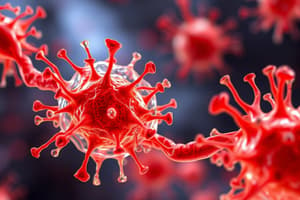Podcast
Questions and Answers
What is the primary purpose of cell death in diseased or damaged cells?
What is the primary purpose of cell death in diseased or damaged cells?
- To ensure removal before posing a health threat (correct)
- To cause cellular growth in surrounding tissues
- To promote inflammation for repair
- To stimulate nearby cell division
Which of the following statements about cell death during development is accurate?
Which of the following statements about cell death during development is accurate?
- It affects the size and shape of limbs and tissues. (correct)
- It occurs randomly without any regulatory pattern.
- It plays no role in determining tissue size.
- It helps in repairing damaged tissues.
How does apoptosis contribute to maintaining tissue or organ size?
How does apoptosis contribute to maintaining tissue or organ size?
- By causing continuous growth without regulation
- By balancing cell division with cell death rates (correct)
- By increasing the rate of cell division significantly
- By eliminating all surrounding cells to allow expansion
What characterizes necrosis compared to apoptosis?
What characterizes necrosis compared to apoptosis?
What potential consequence can arise from an imbalance between cell division and apoptosis?
What potential consequence can arise from an imbalance between cell division and apoptosis?
What happens to cells during the process of apoptosis?
What happens to cells during the process of apoptosis?
What role does apoptosis play in response to drug treatment in liver cells?
What role does apoptosis play in response to drug treatment in liver cells?
Which of the following best describes the process of apoptosis?
Which of the following best describes the process of apoptosis?
What key difference distinguishes necrosis from apoptosis?
What key difference distinguishes necrosis from apoptosis?
Which statement accurately describes the role of caspases in apoptosis?
Which statement accurately describes the role of caspases in apoptosis?
How do phagocytic cells contribute to the process of apoptosis?
How do phagocytic cells contribute to the process of apoptosis?
What is the function of initiator caspases in the apoptotic process?
What is the function of initiator caspases in the apoptotic process?
What happens to the membrane-enclosed fragments of cells undergoing apoptosis?
What happens to the membrane-enclosed fragments of cells undergoing apoptosis?
What role does Bcl2 play in preventing apoptosis?
What role does Bcl2 play in preventing apoptosis?
What happens to Bcl2 upon an apoptotic stimulus?
What happens to Bcl2 upon an apoptotic stimulus?
What can excessive apoptosis result in?
What can excessive apoptosis result in?
Which scenario indicates the consequence of too little apoptosis?
Which scenario indicates the consequence of too little apoptosis?
What triggers Bax/Bak to aggregate on the mitochondrial membrane?
What triggers Bax/Bak to aggregate on the mitochondrial membrane?
Which statement reflects the importance of apoptosis in cellular health?
Which statement reflects the importance of apoptosis in cellular health?
How does Bcl2 contribute to cancer progression?
How does Bcl2 contribute to cancer progression?
What is the primary role of cytochrome C in apoptosis?
What is the primary role of cytochrome C in apoptosis?
Which mechanism initiates apoptosis in response to damaged cells signaling through death receptors?
Which mechanism initiates apoptosis in response to damaged cells signaling through death receptors?
What role does cytochrome C play in intrinsic apoptosis?
What role does cytochrome C play in intrinsic apoptosis?
Which statement regarding extrinsic apoptosis is true?
Which statement regarding extrinsic apoptosis is true?
What is the primary function of Bcl2 proteins in relation to apoptosis?
What is the primary function of Bcl2 proteins in relation to apoptosis?
What initiates the signaling cascade leading to apoptosis when survival factors are bound to cell surface receptors?
What initiates the signaling cascade leading to apoptosis when survival factors are bound to cell surface receptors?
In the context of apoptosis, what does the apoptosome signify?
In the context of apoptosis, what does the apoptosome signify?
How do Bax and Bak proteins contribute to intrinsic apoptosis?
How do Bax and Bak proteins contribute to intrinsic apoptosis?
What is the role of executioner caspases in apoptosis?
What is the role of executioner caspases in apoptosis?
Which pathway is characterized by the activation of Fas receptors?
Which pathway is characterized by the activation of Fas receptors?
What is a key difference between intrinsic and extrinsic apoptosis?
What is a key difference between intrinsic and extrinsic apoptosis?
What determines whether a cell will undergo apoptosis or survive?
What determines whether a cell will undergo apoptosis or survive?
What is the importance of the survival factors in the apoptosis process?
What is the importance of the survival factors in the apoptosis process?
Which component of apoptosis is primarily responsible for caspase activation?
Which component of apoptosis is primarily responsible for caspase activation?
The term 'caspase' in the context of apoptosis generally refers to:
The term 'caspase' in the context of apoptosis generally refers to:
What is the state of initiator procaspases prior to activation during apoptosis?
What is the state of initiator procaspases prior to activation during apoptosis?
What role do adaptor proteins play in the activation of procaspases?
What role do adaptor proteins play in the activation of procaspases?
What is the process referred to as 'cross-cleavage' in the context of caspase activation?
What is the process referred to as 'cross-cleavage' in the context of caspase activation?
Which of the following correctly describes executioner procaspases?
Which of the following correctly describes executioner procaspases?
Which of the following cellular components is NOT affected by caspase activity?
Which of the following cellular components is NOT affected by caspase activity?
What is the result of executioner caspases cleaving the inhibitor of CAD nuclease?
What is the result of executioner caspases cleaving the inhibitor of CAD nuclease?
What characterizes the intrinsic pathway of apoptosis compared to the extrinsic pathway?
What characterizes the intrinsic pathway of apoptosis compared to the extrinsic pathway?
What is a common feature of procaspases in cells under normal conditions?
What is a common feature of procaspases in cells under normal conditions?
Which of the following proteins does NOT participate in the cleavage process by caspases during apoptosis?
Which of the following proteins does NOT participate in the cleavage process by caspases during apoptosis?
How does the arrangement of subunits contribute to the activation of caspases?
How does the arrangement of subunits contribute to the activation of caspases?
Flashcards are hidden until you start studying
Study Notes
Cell Death
- Cells can die by necrosis or apoptosis.
- Necrosis is messy and often triggers an inflammatory response.
- Apoptosis is clean and tidy and does not trigger a response.
Apoptosis - Programmed Cell Death
- Cells shrink, cytoskeleton collapses, nuclear envelope disassembles, and DNA is fragmented.
- The cell surface becomes chemically altered and the dying cell breaks into membrane- enclosed fragments.
- Membrane-enclosed fragments are quickly disposed of by phagocytosis.
Caspases: Proteases Required for Apoptosis
- There are two main types of caspases: initiator and executioner.
- Initiator caspases initiate apoptosis.
- Executioner caspases cleave substrates to dismantle the cell.
Caspase Activation during Apoptosis
- Caspases are present in cells as inactive precursors (procaspases).
- Initiator procaspases exist as inactive monomers and adaptor proteins facilitate dimerization.
- Executioner procaspases exist as inactive dimers and are cleaved by the initiator caspases.
Proteins Cleaved by Caspases
- Nuclear lamins breakdown the nuclear envelope.
- Components of the cytoskeleton collapse cellular structures.
- Cell-cell adhesion proteins are detached from neighboring cells.
- When an inhibitor of the CAD nuclease is cleaved, this triggers DNA fragmentation by CAD.
Extrinsic vs. Intrinsic Apoptosis
- Extrinsic apoptosis is induced by external signals that tell the cell to die.
- Intrinsic apoptosis occurs when the cell responds to damage or the absence of critical survival factors.
Extrinsic Pathway of Apoptosis
- Damaged cells express death receptors (Fas receptor).
- Fas receptors are activated by Fas ligand on killer lymphocytes.
- DISC (death induced signaling complex) is formed in the damaged cell, which enables dimerization of an initiator procaspase (caspase-8), which facilitates its cross-cleavage and activation.
- Activated caspase-8 cleaves executioner caspases, triggering apoptosis.
Intrinsic Apoptosis
- Activated mitochondria play a key role in intrinsic apoptosis by releasing cytochrome C.
- Cytosolic cytochrome C activates an adaptor protein that leads to apoptosome assembly.
- The apoptosome activates initiator pro-caspases.
- The apoptosome recruits and activates initiator pro-caspases.
Survival Factors Can Inhibit Apoptosis
- Survival factors bind to cell surface receptors.
- This triggers a signaling cascade that leads to activation of a transcription factor that stimulates the production of Bcl2.
- Bcl2 is an anti-apoptotic protein.
Balance Between Pro- and Anti-Apoptotic Factors
- Pro and anti-apoptotic proteins belong to the Bcl2 family.
- Anti-apoptotic Bcl2 family proteins (Bcl2 itself and others) inhibit the formation of channels that release cytochrome C.
- Pro-apoptotic Bcl2 family proteins (e.g. Bax, Bak) release cytochrome C.
Bcl2 Inhibits Bax/Bak
- Bcl2 inhibits Bax/Bak, preventing cytochrome C.
- Bax/Bak must oligomerize to form channels that can release cytochrome C.
Too Much Or Too Little Apoptosis
- Too much apoptosis leads to tissue damage.
- Examples: heart attacks, strokes.
- Prevention of normal cell death occurs in many cancers.
- Some cancer cells overproduce anti-apoptotic Bcl2 and suppress apoptosis, leading to tumor formation.
Apoptosis
- Apoptosis is a beautiful, controlled process with many applications in our bodies.
Studying That Suits You
Use AI to generate personalized quizzes and flashcards to suit your learning preferences.




